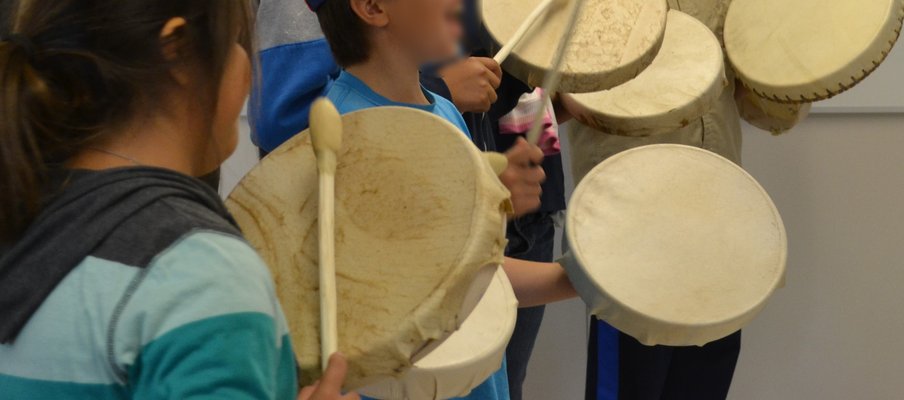Drum-making teaches youth respect, pride and creative expression

Due to the growing popularity of the Seven Stones Community School Drum Club, Chase Shingoose realized he needed more drums. He recognized that if each student had their own drum, they could practice at home, perform at other events, and deepen their connections to their culture.
Shingoose, a Dream Broker and drum leader at the school, says, when kids learn to make a hand drum there are cultural teachings that go along with it. “Not only do they learn the process of making a drum, but they learn how to respect it and take care of it, as the drum is a symbol of pride and identity.”
Thanks to the Creative Kids Dream Broker Program Grant, the Seven Stones Community School in Regina was able to take 17 Indigenous students, from grades one to eight, through the tradition of making a hand drum last June. Shingoose says, having their own drums wouldn’t have been possible without the funding. The Dream Broker program helps innercity youth facing financial barriers access sport, recreational and cultural activities during school hours evenings, weekends and over summer break.
During the drum-making sessions, Shingoose taught the boys the Cree tradition of drum-making as he was taught. He told them, “the drum has a spirit within it, like a Mooshum,” and that is why it’s important to honour and take care of it. He also talked about how the drum will give them courage and keep them safe.
He says, the students had so much fun making the drums and were proud of their accomplishment. They wanted to show everyone when they were done. Now, because they have their own drum, they can participate in singing and drumming outside of school hours, as well as practice at home.
Having their own drum creates more opportunities for the students. Shingoose says, “It’s a pathway that leads to other cultural teachings and cultural involvement. When they take the drum home it creates conversation with their parents, their friends and siblings. They aspire to learn more about their language or ask their parents, ‘can you take me to a round dance?' and seek out time with Knowledge Keepers and Elders.”
For Shingoose, one particular student stands out as a testament to why cultural connection is important for Indigenous kids experiencing the effects of intergenerational trauma. He says he invited a grade one student, who was in foster care and was often in the principal’s office due to behaviour issues, to participate in the drum program. Even though this student struggled in his regular classroom and with playing with others, he never struggled in the drum club. According to Shingoose, he learned quickly and asked to drum all the time. He kept asking if he could have his own drum. It was apparent that the student’s behaviour began to improve as “he found a connection, his voice, a sense of belonging and something that made him experience joy”.
Shingoose adds, this student, “is always number one on the list to send to performances in and outside of the school because he is so respectful and has become a very strong leader”, all from learning to play a drum and its connection to his culture.
The Dream Broker program, offered in 11 schools in Saskatchewan, is supported with funding from Sask Lotteries Trust Fund. This program received additional support from Creative Kids.




